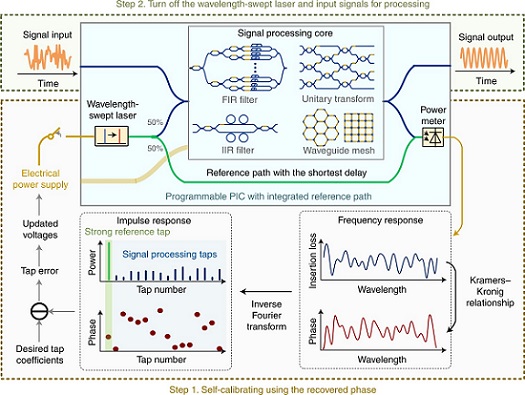A self-calibrating photonic integrated circuit (PIC) developed by Monash University and RMIT scientists holds immense promise for the development of artificial intelligence and optical networking. The researchers said that their technology offers a replacement option for bulky 3D optics with a wafer-thin slice of silicon.
The collaborators cited safer driverless cars capable of instantly interpreting their surroundings, the use of AI to more rapidly diagnose medical conditions, increasing the speed of natural language processing, and helping to create smaller switches for reconfiguring optical networks as applications that the work supports.
The self-calibrating programmable photonic filter chip features a signal processing core and an integrated reference path for self-calibration.
“Self-calibration is significant because it makes tunable photonic integrated circuits useful in the real world; applications include optical communications systems that switch signals to destinations based on their color, very fast computations of similarity (correlators), scientific instrumentation for chemical or biological analysis, and even astronomy,” said Arthur Lowery, lead investigator and Monash University ARC Laureate Fellow Professor.

A self-calibrating programmable photonic filter chip features a signal processing core and an integrated reference path for self-calibration. The chip and a corresponding technique developed by a team in Australia enables the quick and reliable switch of data streams from one destination to another. The conceptual diagram indicates the self-calibration of the integrated broadband PIC. Courtesy of Monash University.
The advancement is analogous to the improvements seen in electronics with the stability of radio filters using digital techniques, enabling mobile phones to operate on the same portion of the spectrum, Lowery said. The chips feature similar architectures, though the newly developed optical chips can operate on signals with terahertz bandwidths.
According to Lowery, the breakthrough technology complements the work of Monash University’s Bill Corcoran. In 2020 Corcoran developed an optical microcomb chip that can squeeze three times the traffic of Australia’s internet through a single optical fiber. The optical microcomb chip built multiple lanes of the so-called superhighway.
The self-calibrating chip in the current work has created the “on and off ramps” and “bridges” that connect them all and allow greater movement of data, according to the researchers.
“The idea that a device can have an on-chip reference system that allows all its components to work as one is a technological breakthrough that will allow us to address bottleneck internet issues by rapidly reconfiguring the optical networks that carry our internet to get data where it’s needed the most,” said RMIT professor Arnan Mitchell.
Photonic circuits manipulate and route optical channels of information and demonstrate some computational ability — for example, searching for patterns. Pattern searching is vital to applications such as medical diagnostics, autonomous mobility, internet security, threat identification, and search algorithms.
Developing chips for such tasks, however, is difficult and expensive, as it requires manufacturing precision down to nanometer level. Self-calibration overcomes this problem.
“Our solution is to calibrate the chips after manufacturing, to tune them up in effect by using an on-chip reference, rather than by using external equipment,” Lowery said. “We use the beauty of causality, effect following cause, which dictates that the optical delays of the paths through the chip can be uniquely deduced from the intensity versus wavelength, which is far easier to measure than precise time delays.”
The team also added a calibrated reference path to its chip design, which it said provides the settings needed to “dial up,” as well as the desired switching function or spectral response. The method demonstrated by the collaborators enables the ability to tune a chip in a single step, in turn enabling the quick and reliable switch of data streams from one destination to another.
Reliable tuning of photonic chips opens up many other applications, such as optical correlators, which can almost instantaneously find patterns of data in data streams such as images.
“As we integrate more and more pieces of bench-sized equipment onto fingernail-sized chips, it becomes more and more difficult to get them all working together to achieve the speed and function they did when they were bigger,” said Andy Boes, a professor at the University of Adelaide. “We overcame this challenge by creating a chip that was clever enough to calibrate itself so all the components could act at the speed they needed to in unison.”
The research was published in Nature Photonics (www.doi.org/10.1038/s41566-022-01020-z).